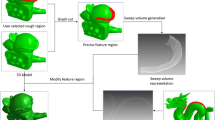Abstract
Among the various techniques for displaying solid objects, ray tracing is the most popular method for sweep-generated objects, owing to its simplicity and effectiveness. The main problem in ray tracing is to find the point of intersection between the ray and the object. By taking consideration of the special features of a surface generated by sweep, the ray/object intersection problem can be reduced to 2-D planar problem. This paper presents a raycasting technique for displaying Sweep-CSG-represented solids. This technique works directly on the Sweep-CSG representation and does not require explicit boundary information. Boundary information is, however essential for line-drawing outputs. In this paper, boundary-evaluation techniques for obtaining edges of a Sweep-CSG solid are described. Special techniques for evaluating the boundaries of a solid generated by sweeping another solid are also discussed.
Similar content being viewed by others
References
Bronsvoort WF, Klok F (1985) Ray tracing generalized cylinders. ACM Trans Graph 4(4):291–303
Glassner AS (1984) Space subdivision for ray tracing. IEEE Comput Graph Appl 14(10):15–22
Goldstein RA, Nagel R (1971) 3D visual simulation. Simulation 16(1):25–31
Hanrahan P (1983) Ray tracing algebraic surfaces. Comput Graph and Image Process 17(3):83–90
Hui KC (1990) Solid modelling and its application in mould design — a sweep primitive approach. PhD dissertation, University of Hong Kong
Kajiya JT (1983) New techniques for ray tracing procedurally defined objects. Comput Graph and Image Process 17(3):91–102
Mortenson ME (1985) Geometric modelling. John Wiley and Sons, New York
Requicha AAG (1977) Mathematical models of rigid solid objects. Technical Memo No. 28, Production Automation project, University of Rochester
Requicha AAG (1980) Representation for rigid solids: theory, methods and systems. ACM Comput Survey 12(4):437–464
Requicha AAG (1984) Boolean operations in solid modelling: boundary evaluation and merging algorithms. Technical Memo No. 26, Production Automation Project, University of Rochester
Requicha AAG, Tilove RB (1978) Mathematical foundations of constructive solid geometry: general topology of closed regular sets. Technical Memo No. 27a, Production Automation Project, University of Rochester
Roth SD (1982) Ray casting for modelling solids. Comput Graph and Image Process 18(2):109–144
Tan ST, Yuen MMF, Hui KC (1987) Modelling solids with sweep primitives. Comput Mech Eng 6(2):60–73
Tilove RB (1977) A study of geometric set-membership classification. MS thesis, University of Rochester, New York
Tilove RB (1980) Set Membership classification: a unified approach to geometric intersection problems. IEEE Trans Comput C-29(10):874–883
Tilove RB (1981) Line/polygon classification: a study of the complexity of geometric computation. IEEE Comput Graph Appl 1(2):75–83
Tuy HK, Tuy LT (1984) Direct 2-D display of 3-D objects. IEEE Comput Graph Appl 4(10):29–33
Van Wijk JJ (1984a) Ray tracing objects defined by sweeping a sphere. Proceedings Eurographics 84, pp 73–83
Van Wijk JJ (1984b) Ray tracing objects defined by sweeping planar cubic splines. ACM Trans Graph 3(3):223–237
Woodwark JR, Quinlan KM (1982) Reducing the effect of complexity on volume model evaluation. Computer Aided Design 4(2):89–95
Author information
Authors and Affiliations
Rights and permissions
About this article
Cite this article
Hui, K.C., Tan, S.T. Display techniques and boundary evaluation of a Sweep-CSG modeller. The Visual Computer 8, 18–34 (1991). https://doi.org/10.1007/BF01900843
Issue Date:
DOI: https://doi.org/10.1007/BF01900843




